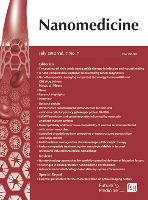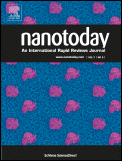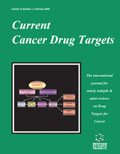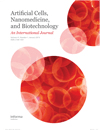
Cancer Nanotechnology
Scope & Guideline
Empowering Breakthroughs in Cancer Treatment via Nanotechnology
Introduction
Aims and Scopes
- Nanoparticle Design and Synthesis:
Research on the development of novel nanoparticles, including their synthesis and functionalization, to enhance drug delivery and therapeutic efficacy in cancer treatment. - Targeted Drug Delivery Systems:
Studies focusing on the use of nanoparticles for targeted delivery of chemotherapeutic agents, aiming to minimize side effects while maximizing treatment efficacy. - Theranostics:
Integration of therapeutic and diagnostic capabilities in nanoparticles to create theranostic agents that can monitor treatment response and improve personalized medicine. - Mechanistic Studies:
Investigations into the cellular and molecular mechanisms of action of nanoparticles in cancer therapy, including their interactions with cancer cells and the tumor microenvironment. - Biocompatibility and Toxicity Assessment:
Research evaluating the biocompatibility and potential toxicity of nanomaterials to ensure their safety in clinical applications. - Emerging Nanotechnologies:
Exploration of cutting-edge technologies, such as bioengineered nanoparticles and smart delivery systems, that represent the forefront of cancer nanotechnology.
Trending and Emerging
- Combination Therapies:
An increasing number of studies are exploring combination therapies that incorporate nanoparticles with other treatment modalities, such as chemotherapy, immunotherapy, and radiation therapy, to enhance overall treatment efficacy. - Smart Nanocarriers:
Research on intelligent nanocarriers that respond to specific stimuli (e.g., pH, temperature, or light) for controlled drug release is gaining momentum, allowing for more precise and effective cancer treatment. - Extracellular Vesicles and Biomimetic Nanoparticles:
Emerging interest in using extracellular vesicles and biomimetic nanoparticles for drug delivery, leveraging their natural targeting abilities and biocompatibility to improve therapeutic outcomes. - Nanotechnology in Immunotherapy:
A notable trend in utilizing nanoparticles to enhance cancer immunotherapy, including the delivery of immune checkpoint inhibitors and other immunomodulatory agents, is becoming increasingly prevalent. - Nanoparticle-mediated Gene Therapy:
Growing research focus on the development of nanoparticle-based systems for the delivery of RNA and DNA therapeutics, such as siRNA and gene editing tools, to target cancer cells at the genetic level. - Regenerative Nanotechnology:
Investigation into the role of nanoparticles in promoting tissue regeneration and repair in the context of cancer therapy is emerging as a novel area of research.
Declining or Waning
- Conventional Chemotherapy Alone:
There is a noticeable decrease in studies focusing solely on conventional chemotherapy without the incorporation of novel nanotechnology approaches, indicating a shift towards combination therapies involving nanoparticles. - Single Modality Treatments:
Research centered on single modality treatments, such as traditional drug delivery methods without the use of nanocarriers, is becoming less common as the field increasingly favors multimodal strategies that combine various therapeutic approaches. - Basic Nanoparticle Characterization:
While fundamental studies on nanoparticle characterization were once prevalent, the focus has shifted towards applications and therapeutic outcomes, leading to fewer publications solely dedicated to characterization without a direct link to cancer therapy. - Non-targeted Nanoparticle Applications:
There is a declining emphasis on non-targeted applications of nanoparticles in cancer therapy, as more researchers pursue targeted delivery systems that enhance therapeutic efficacy and reduce off-target effects.
Similar Journals

Biomaterials Research
Fostering collaboration in the world of biomaterials.Biomaterials Research, published by the American Association for the Advancement of Science, is a prominent open access journal established in 2014, dedicated to advancing the field of biomaterials. Based in the United Kingdom, this journal has swiftly become an essential platform for researchers and practitioners, offering groundbreaking insights in biomaterials, biomedical engineering, ceramics and composites, and miscellaneous medical fields. With its impressive Q1 ranking across multiple relevant categories in 2023 and its strong Scopus rankings, including a remarkable 90th percentile in the medicine category, Biomaterials Research showcases high-quality, peer-reviewed research designed to address both practical and theoretical challenges in biomaterials science. As an open access journal, it promotes wider dissemination and accessibility of research findings, crucial for fostering innovation and collaboration within the scientific community. Researchers, professionals, and students alike are encouraged to contribute, read, and engage with the latest developments in this dynamic field.

Nanomedicine
Exploring the Intersection of Nanotechnology and MedicineNanomedicine, published by Future Medicine Ltd, is a premier academic journal dedicated to the rapidly evolving field of nanotechnology in medicine. With an emphasis on innovative research and applications, this journal encompasses a broad spectrum of topics including bioengineering, biomedical engineering, and nanoscience, among others. Featuring an impressive Q1 ranking in Development and multiple Q2 rankings across significant categories, it serves as a pivotal resource for researchers and professionals aiming to stay at the forefront of advancements in these disciplines. While the journal is not open access, it is accessible through various institutional subscriptions, ensuring wide dissemination of cutting-edge findings. Notably, it has achieved substantial impact within the scientific community, indicated by its high rankings in Scopus and overall commitment to enhancing the understanding and application of nanomedicine. This journal is a vital conduit for fostering collaborations and innovations that transcend traditional medical paradigms.

International Journal of Pharmaceutics-X
Advancing pharmaceutical innovation for a global impact.International Journal of Pharmaceutics-X is a premier open access journal published by Elsevier, dedicated to advancing knowledge and research in the field of pharmaceutical sciences. Launched in 2019, this journal has quickly ascended to the Q1 category in the 2023 Category Quartiles, reflecting its high impact and the quality of research it promotes. With a current Scopus ranking of #49 out of 183 in the Pharmacology, Toxicology and Pharmaceutics category, this journal occupies the 73rd percentile, showcasing its significant influence within the scholarly community. Emphasizing innovative research and novel applications, the International Journal of Pharmaceutics-X offers a platform for researchers, professionals, and students to disseminate their findings, making crucial contributions to the global pharmaceutical landscape. The journal is based in the Netherlands, presenting a vibrant hub for scientific discourse and collaboration in a rapidly evolving field.

Advanced NanoBiomed Research
Exploring the Future of NanobiotechnologyAdvanced NanoBiomed Research is a pioneering open-access journal committed to advancing the interdisciplinary field of nanobiotechnology, published by WILEY-V C H VERLAG GMBH. Since its inception in 2021, this journal has provided a platform for innovative research that bridges the gap between engineering, medicine, and materials science. With impressive rankings in Scopus, positioning it within the top quartiles of various categories, Advanced NanoBiomed Research aims to disseminate high-quality research that contributes to the understanding and application of nanomaterials in biomedical contexts. As it encompasses a wide scope—from applied microbiology to biomaterials—it serves as an essential resource for researchers, professionals, and students eager to explore the cutting-edge developments in the field. The journal promotes a collaborative environment where emerging ideas can flourish, ensuring that vital advancements in nanobiomedicine can be shared and built upon within the scientific community.

Nano Today
Navigating the landscape of advanced nanotechnological research.Nano Today is a prestigious journal published by ELSEVIER SCI LTD that stands at the forefront of nanoscience and nanotechnology research. With an impact factor that underscores its significance, this journal has achieved remarkable rankings in several key categories as of 2023, including Q1 positions in Bioengineering, Biomedical Engineering, Biotechnology, Materials Science, and Pharmaceutical Science, making it an essential resource for scholars and professionals alike. ISSN 1748-0132 and E-ISSN 1878-044X, the journal serves as a vital platform for disseminating cutting-edge research findings and innovative applications in the field. Although open access options are not available, the journal's rich repository of peer-reviewed articles provides invaluable insights into the latest advancements in nanotechnologies. Based in the Netherlands, Nano Today not only connects a global network of researchers but also propels forward the conversation on the transformative potential of nanomaterials across multiple disciplines. With a commitment to advancing knowledge and fostering innovation, Nano Today is an indispensable tool for academics and practitioners dedicated to pushing the boundaries of scientific exploration.

Journal of Reports in Pharmaceutical Sciences
Unveiling the Future of Biopharmaceutical Technologies.Journal of Reports in Pharmaceutical Sciences is a pivotal publication in the realm of pharmaceutical research, disseminating innovative findings that cater to the evolving landscape of pharmacology, toxicology, and biomedical engineering. Published by Wolters Kluwer Medknow Publications, the journal serves as a bridge for scholars and practitioners aiming to enhance their understanding of drug development, therapeutic advances, and biopharmaceutical technologies. With an ISSN of 2322-1232 and E-ISSN 2322-5106, it has established its relevance from 2012 to 2022, occupying notable quartile rankings, including Q3 in Pharmacology, Toxicology, and Pharmaceutics. Despite being categorized in Q4 in some areas, the journal's commitment to quality research ensures it remains a respected platform for disseminating significant insights. Researchers, professionals, and students alike will find this journal an indispensable resource for staying updated on critical advancements in pharmaceutical sciences, making it a go-to source for impactful studies that shape industry practices and academic inquiries.

CURRENT CANCER DRUG TARGETS
Exploring the latest breakthroughs in cancer drug targets.CURRENT CANCER DRUG TARGETS is a prominent academic journal published by Bentham Science Publishers Ltd, focusing on the critical intersection of cancer research and innovative drug development. Since its inception in 2001, this journal has offered a platform for the dissemination of cutting-edge research aimed at advancing targeted cancer therapies, contributing significantly to the fields of Cancer Research, Drug Discovery, Oncology, and Pharmacology. With a respectable impact factor and consistent ranking in its respective categories, including Q2 in Drug Discovery and Pharmacology, it positions itself as an invaluable resource for researchers, clinicians, and students alike. CURRENT CANCER DRUG TARGETS is dedicated to enhancing our understanding of novel therapeutic targets and methods, thereby fostering a collaborative environment for knowledge exchange in the ever-evolving landscape of cancer treatment.

JOURNAL OF MATERIALS SCIENCE-MATERIALS IN MEDICINE
Transforming Healthcare with Cutting-edge Materials ResearchJOURNAL OF MATERIALS SCIENCE-MATERIALS IN MEDICINE is a leading peer-reviewed journal published by Springer, dedicated to advancing the field of biomedical materials science. With an ISSN of 0957-4530 and E-ISSN 1573-4838, this Open Access journal has been committed to providing researchers and professionals with freely accessible, high-quality research since 2021. It features an extensive scope spanning bioengineering, biomaterials, biomedical engineering, and biophysics, reflecting its significant impact within these interdisciplinary domains. Recognized within the Q2 category of the 2023 rankings in multiple fields, the journal proudly positions itself as a crucial resource for innovative materials that contribute to advancements in medical applications. With impressive Scopus rankings, including 26th in Biophysics and 40th in Materials Science for Biomaterials, researchers, students, and industry professionals alike can rely on this publication for cutting-edge insights that drive the future of medical materials and technologies. Based in Dordrecht, Netherlands, the journal provides a vibrant platform for sharing groundbreaking discoveries and fostering collaborative research among a global audience.

Artificial Cells Nanomedicine and Biotechnology
Elevating Biomedical Research to New Heights of Innovation.Artificial Cells Nanomedicine and Biotechnology is a prestigious peer-reviewed journal published by TAYLOR & FRANCIS LTD, specializing in the rapidly evolving fields of biomedical engineering, biotechnology, and nanomedicine. Established in 2013 and operating under an open-access model since 2019, the journal aims to bridge the gap between fundamental science and real-world medical applications, showcasing cutting-edge research that advances our understanding of artificial cells and their biotechnological applications. With an impressive impact factor and ranking in the Q2 quartile across various categories, including Biomedical Engineering, Medicine, and Pharmaceutical Sciences, the journal is a leading platform for innovative studies that contribute significantly to the realm of healthcare and therapeutic development. Researchers, professionals, and students alike will find invaluable insights and advancements within its pages, positioning it as a vital resource for those dedicated to pushing the boundaries of science and improving patient outcomes.

Anti-Cancer Agents in Medicinal Chemistry
Empowering researchers with cutting-edge insights in oncology.Anti-Cancer Agents in Medicinal Chemistry is a pivotal journal in the realm of cancer research, published by Bentham Science Publishers in the United Arab Emirates. With an ISSN of 1871-5206 and an E-ISSN of 1875-5992, this esteemed journal has been disseminating high-quality research since its inception in 2006, and is set to continue through 2024. The journal is categorized in the third quartile (Q3) across key areas including Cancer Research, Molecular Medicine, and Pharmacology, highlighting its essential role in providing valuable insights to the scientific community. Despite its open-access status being unspecified, researchers benefit from the rigorous peer-review process ensuring the publication of significant advancements. The journal ranks well within Scopus, particularly in the fields of Pharmacology and Cancer Research, which positions it as a notable resource for professionals, students, and researchers aiming to deepen their knowledge in anti-cancer strategies. Through its comprehensive scope, the journal aims to bridge the gap between medicinal chemistry and clinical applications, making it an indispensable tool for those dedicated to advancing cancer therapeutics.